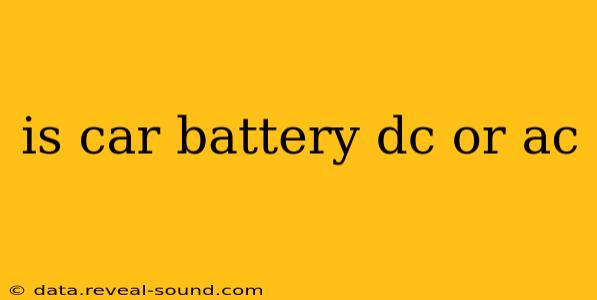The simple answer is: a car battery is DC (Direct Current). This is a fundamental aspect of automotive electrical systems and understanding the difference between DC and AC is crucial for anyone working on or around cars.
Let's delve deeper into why car batteries use DC and explore some related questions.
What is the Difference Between DC and AC?
Before we can fully understand why car batteries use DC, it's helpful to clarify the difference between direct current (DC) and alternating current (AC).
-
Direct Current (DC): The electrons flow in one consistent direction. Think of a battery – the electrons always flow from the negative terminal to the positive terminal. This is the type of electricity used in most electronic devices, including your car.
-
Alternating Current (AC): The electrons periodically reverse their direction of flow. This is the type of electricity that comes out of your wall outlets at home. The current changes direction many times per second (typically 50 or 60 Hz).
Why Do Cars Use DC Power?
Cars use DC power primarily because of the nature of the battery itself. Lead-acid batteries, the most common type in vehicles, inherently produce direct current. The chemical reactions within the battery generate a flow of electrons in one direction only. Designing a system to convert this DC to AC and then back to DC to power various components would be inefficient and complex. Using DC directly simplifies the electrical system and improves efficiency.
What About the Alternator? Doesn't it Produce AC?
Yes, the alternator, which recharges the battery, does produce alternating current. However, a critical component called a rectifier converts this AC power into DC before it reaches the battery and the vehicle's electrical system. This ensures that the battery is charged correctly and that the vehicle's electronics receive a consistent DC power supply.
Can I Use AC Power in My Car?
No, you should never attempt to directly connect AC power to your car's electrical system. Doing so will likely damage the vehicle's electronics and could potentially create a dangerous situation. The car's components are designed to operate solely on DC power.
What are the Advantages of Using DC in Cars?
Using DC in cars offers several key advantages:
- Simplicity: DC systems are simpler to design, install, and maintain than AC systems.
- Efficiency: Directly using the battery's DC output minimizes energy losses during conversion.
- Compatibility: Most automotive components are designed to operate on DC power.
How Does the Car Battery Power Different Components?
The car battery provides the necessary DC power to a wide range of components, including:
- Engine Starting: The starter motor needs a significant burst of power to crank the engine, provided directly by the battery.
- Lighting: Headlights, taillights, and interior lights all operate on DC.
- Electronics: The radio, infotainment system, and other electronic devices rely on the DC power from the battery.
Understanding the fundamental difference between AC and DC power and why cars utilize DC is crucial for basic car maintenance and troubleshooting. This knowledge can help you avoid costly mistakes and ensure the safe and efficient operation of your vehicle's electrical system.
